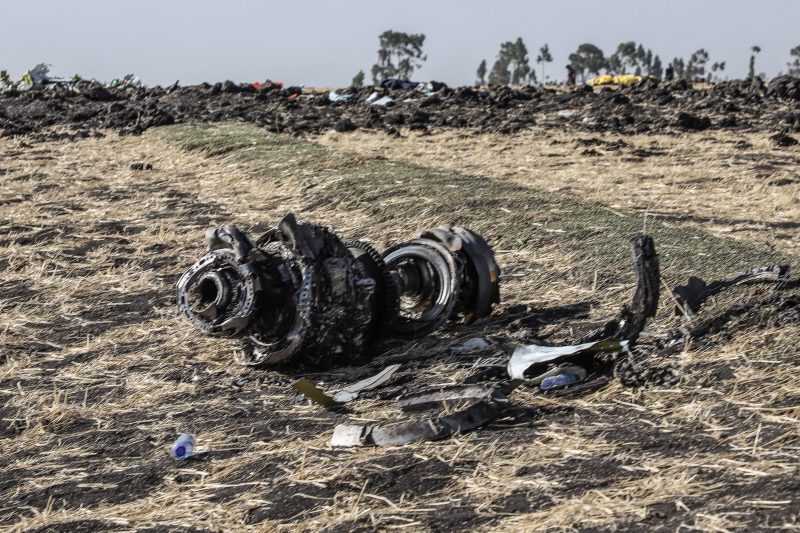Ethiopian crew followed procedure but unable to control jet: inquiry
The plane crashed near Bishoftu, some 60 kilometres southeast of Addis Ababa, killing all 157 people onboard (Michael TEWELDE)
Addis Ababa (AFP) – The crew of the Ethiopian Airlines plane that crashed last month, killing 157 people, repeatedly followed procedures recommended by Boeing, but were unable to regain control of the jet, the investigators’ report showed Thursday.
The initial probe appears to confirm concerns about the flight control system on the Boeing 737 MAX 8 model, with data echoing that from the crash of the Indonesian Lion Air 737 MAX 8 flight in October last year which killed 189 people.
The full report has not been publicly released, but according to a draft copy seen by AFP, shortly after take-off a sensor recording the level of the plane began transmitting faulty data, prompting the autopilot system to point the nose downwards.
“The crew performed all the procedures repeatedly provided by the manufacturer, but was not able to control the aircraft,” said Ethiopian Transport Minister Dagmawit Moges, unveiling results of the preliminary probe into the crash.
The report recommends “the aircraft flight control system shall be reviewed by the manufacturer,” Dagmawit said.
“Aviation authorities shall verify that the review of the aircraft flight control system has been adequately addressed by the manufacturer before the release of the aircraft for operations,” she added.
The release of the report came after the US Federal Aviation Administration (FAA) announced a review of the certification of the automated flight control system on the 737 MAX. Boeing is reviewing the report.
The Ethiopian Airlines flight was headed to Nairobi on a clear morning on March 10 when so-called Angle of Attack sensors on either side of the nose of the plane began sending conflicting information to the auto pilot system shortly after take-off.
According to report AFP saw, the nose of the plane pointed down four times without pilot input.
The autopilot was switched off at some point and the captain called out “pull up” three times to his first officer as the pair battled to gain control.
Three minutes after take off and three minutes before the crash, the captain asked the first officer to try the manual trim system, which changes the level of the plane. He replied that it was not working.
They asked to turn back, but it was too late. The plane pitched down at a 40-degree angle, smashing into a field outside Addis Ababa at about 500 knots (1,000 kilometres per hour).
Both engines were buried at a depth of 10 metres, in a crater 28 metres wide and 40 metres long, with fragments of debris found within a radius of about 300 metres.
“This accident was not survivable,” said the report.
Citizens from over 30 countries were on board.
– Anti-stall system –
The report ratchets up pressure on Boeing to fix the flight control system on the MAX 8, which has been grounded worldwide.
Shortly after the Lion Air crash last year, Boeing issued a bulletin reminding operators of emergency guidelines to override the anti-stall system, amid indications it had received erroneous information from Angle of Attack (AoA) sensors during that disaster.
The Maneuvering Characteristics Augmentation System (MCAS) is designed to automatically lower the aircraft’s nose if it detects a stall or loss of airspeed.
It was developed specifically for the MAX 8 — whose larger engines placed higher on the plane can tip the nose up which can lead to the aircraft stalling.
However in the case of both crashes, faulty data appears to have led the anti-stall system to kick in and point the plane downwards at a dangerous angle.
The Wall Street Journal reported Wednesday that pilots had shut off the anti-stall system, but switched it back on because they could not regain control, citing people briefed on the preliminary findings.
The head of the accident investigation bureau Amdiye Ayalew said the full probe would take six months to a year, but that there had been no sign of “foreign object damage” to the aircraft.
“Within this one year we’ll analyse whether other problems are existing on this aircraft,” he said.
– ‘Proud’ of pilots –
The head of Ethiopian Airlines Tewolde GebreMariam said he was proud of the efforts of the pilots in trying to stop their jet from crashing.
“We are very proud of our pilots’ compliances to follow the emergency procedures, and high level of professional performances in such extremely difficult situations,” he said in a statement.
Boeing last week gathered hundreds of pilots and reporters for a presentation on proposed MCAS changes — including the system no longer repeatedly making corrections when pilots try to regain control.
The company is anxious to win approval for a remedy that could get the planes back in the air.
The FAA said Monday that Boeing needed to undertake more work on the proposed fix before it could be submitted for review.
Disclaimer: Validity of the above story is for 7 Days from original date of publishing. Source: AFP.


